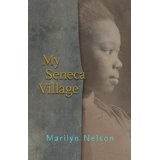My Seneca Village...Marilyn Nelson Netgalley ARC
 |
| "Jesus says God rejoices over each found sheep." New Hope Missionary A.M.E. Zion, August 4, 1833 |
This early in the Nineteenth century it was surprising to learn that African Americans enjoyed Shakespeare. James Hewlett, was a "famous black tragedian." Perhaps, he acted the part of Othello. In My Seneca Village by Marilyn Nelson, these words are written. "Imagine a theatre where respectable colored families can float on the blue cloud thrill of poetry..." Elizabeth and Obadiah are two of the black people who enjoyed Shakespearean theatre and loved books.
While reading these poems, I realized the importance of caring for the smallest, tattered or everyday item in the home. These will become precious to future generations. For example, Marilyn Nelson writes about a petticoat owned by Ada Thompson in 1835. A soiled, used petticoat becomes beautiful again in a poem written here. When the thirteen year old girl complains about wearing a hand me down petticoat, she's told "Wake up to the world: a colored girl can't be so sensitive!"
Since races will always, it seems, meet with disdain from a segment of society and feel inferior, this is one book that offers kindness, a relief from those stressful times. Yes, I am somebody becomes the shout from the mouths of the oppressed. Mrs. Maria W. Stewart (1803-1879), ca. 1845 asks and answers questions in a voice of passion. Her fist is used as emphasis during a sermon.
My Seneca Village makes us walk gently across the grass of Central Park as we remember the buried bones beneath our feet. The book is lovely as far as the cover goes. Unfortunately, I had an ebook and not a hardback. If I had been blessed with a hardback, I would have a treasure to display and share with family and friends that would last forever. My one regret is that I can not visit the churches where they sang spirituals and heard preaching and prayed fervent prayers during their lifetime. namelos.com/marilyn-nelson/



Comments